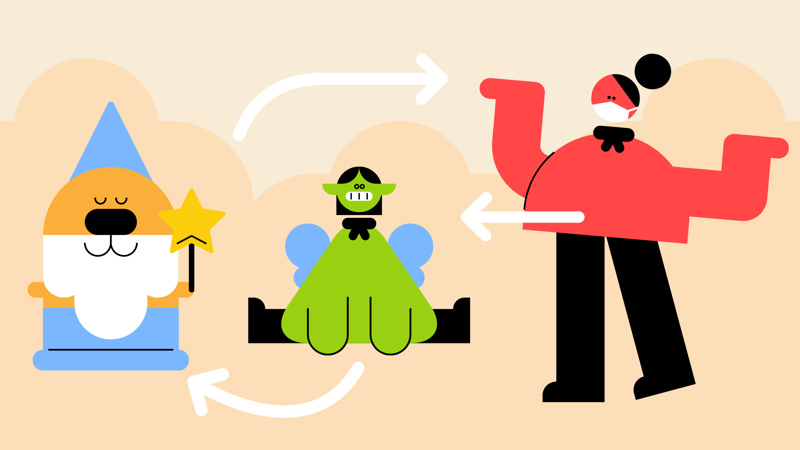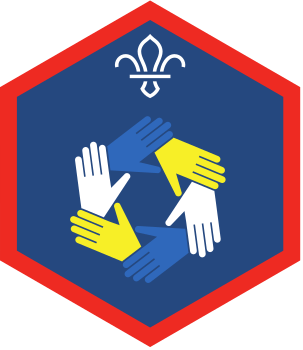
Play Giants, Wizards and Elves
You’ll need
- Something to mark lines (for example, chalk, masking tape, or rope)
- Something to mark team area (for example chalk or cones)
Before you begin
- Use the safety checklist to help you plan and risk assess your activity. Additional help to carry out your risk assessment, including examples can be found here. Don’t forget to make sure all young people and adults involved in the activity know how to take part safely.
- Make sure you’ll have enough adult helpers. You may need some parents and carers to help if you’re short on helpers.
Planning this game
- Divide space into two areas (one for each team) with a line of tape, cones or chalk.
Explaining the rules
- Tell everyone that there are three creatures to pick from, Giants, Wizards and Elves.
- Show everyone how to demonstrate the three creatures in the game using these actions:
- Giants stand on their toes, raise their arms, and growl menacingly.
- Wizards crouch slightly, wave their magical fingers, and say spells.
- Elves crouch down low, cup their hands behind their ears, and squeak.
Getting ready to play
- Everyone should split into two teams.
- Each team should get into their space and stand along the line, making sure they’re facing a member of the opposing team.
- A team captain should be chosen from each team and stand behind their team, away from the line.
- Explain that in this game, giants squash elves, elves outsmart wizards and wizards zap giants. It's a bit like rock, paper, scissors.
- Teams will need to choose one of the creatures, then come back to the line and show their chosen creature using the actions. The team captain can help them to decide.
Playing the game
- To begin, each team turns and looks at their team captain.
- Each team should decide together whether they’ll be giants, wizards or elves, without making it obvious to the other team. People could do the actions or whisper their choice. The team captain can help lead the decision.
- When each team have made their decision, they should quietly and quickly stand back by the line and wait to be asked to show their chosen creature using the correct actions.
- The person leading the activity should count down from three. When they say ‘go’, everyone should show which creature they’ve chosen to be without leaving their side of the line.
- Remember, giants grow and growl, wizards crouch and say spells, and elves crouch down low and squeak.
- Everyone should keep doing their action until the person leading the game announces the winner.
- Rounds should only last for a few seconds.
- The winning team should get one point.
- Play as many rounds as you like. The winning team is the one with the most points at the end.
Reflection
In this game, everyone needed to work well as a team and choose their creature carefully. The game can change as it’s played, for example, if a team favours one creature.
If it's played as a wide game, people may begin nearer or further to a particular safe space. What did everyone think made their team work well? Did they communicate clearly, solve problems together, and come to an agreement on what to do?
Remember this line from The Jungle Book: ‘For the strength of the pack is the wolf, and the strength of the wolf is the pack’. What do people think this means?
Safety
All activities must be safely managed. You must complete a thorough risk assessment and take appropriate steps to reduce risk. Use the safety checklist to help you plan and risk assess your activity. Always get approval for the activity, and have suitable supervision and an InTouch process.
- Active games
The game area should be free of hazards. Explain the rules of the game clearly and have a clear way to communicate that the game must stop when needed. Take a look at our guidance on running active games safely.
This game’s a great ice-breaker, but it also works well as a wide game if people would like to play it on a larger scale.
You’ll still need clear boundaries and safe spaces to keep the game fair.
This game is like ‘Rock, Paper, Scissors’. You could play the game with the familiar actions of rock, paper and scissors if it’s easier for everyone. If you’re using the magical creatures, adapt the actions if needed to make sure everyone can do them.
All Scout activities should be inclusive and accessible.
This game can be adjusted to fit your programme. The group could come up with new creatures or actions that are relevant to a session.
It’s up to them to decide how they’ll interact in the game and what sounds and actions they’ll do.
For example, if you’re looking at space, why not use aliens, spaceships and meteorites?
Once everyone knows the rules, let young people take control and lead the game.


